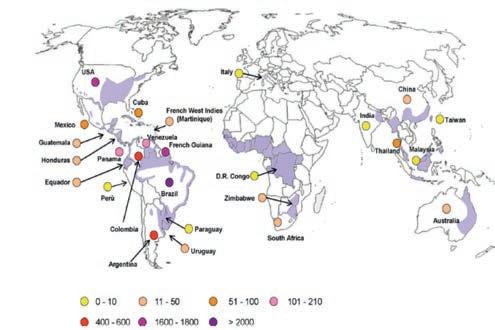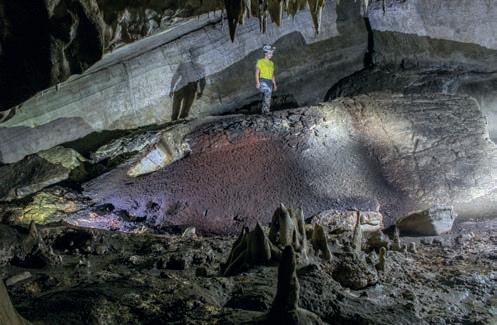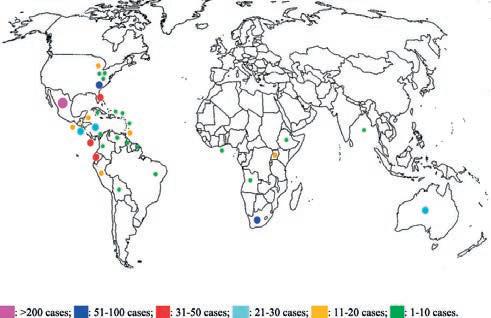
7 minute read
Expedition medicine - Histoplasmosis, aka Darling’s Disease aka Cave Disease
Histoplasmosis, aka Darling’s Disease aka Cave Disease
Giuseppe Giovine
Advertisement
Out of all the illnesses that it is possible to contract by visiting caves, perhaps the one we can consider the most distinctive is histoplasmosis. Although not very widespread at our latitude, it is not entirely absent, either. It is, however, endemic in the southern USA (the valleys of the Ohio and Mississippi rivers, part of northern Maryland, southern Pennsylvania, central New York state and in Texas), as well as in Mexico, Panama, Ecuador,
Epidemiology of histoplasmosis (from Dr. Pedro Torres Gonzalez, 70th anniversary of the Instituto Nac. de Ciencias Medicas y Nutricion Salvador Zubiran)

Cuba, Paraguay and a large part of South America. What causes the disease to take hold is not any form of bacteria, like those that most frequently cause urinary tract infections or skin conditions or lung disease, nor is it any sort of virus (viruses are normally responsible for influenza); rather, it is caused by a fungus! It is not uncommon for a fungus such as candida, or ringworm, to cause disease, but for one to invade, develop and cause illness through the lungs is an unusual phenomenon. This particular fungus, Histoplasma capsulatum, thrives in dark, warm, humid situations, but it can also survive under extreme environmental conditions (from -6°C to 50°C), producing spores – organs of reproduction and dissemination – in any surroundings, and is capable of
Large deposit of dried guano in the cave of Rancho Nuevo, Chiapas, Mexico
survival for prolonged periods and of re-growing once the temperature returns within the range of 18°C to 32°C, with relative humidity above 65%. As such, it comes as no surprise that the fungus is to be found in certain areas, including caves. Histoplasms do not just attack human beings, but also rodents, birds, dogs, cats and bats. The elements are as follows: a warm, damp cave, in Mexico or another equatorial zone, and the presence of bats. But does this mean that we will all become ill? Certainly not. It is unusual to be afflicted by the disease visiting or even living in those geographical areas – you really have to try hard to catch it! People become infected mainly by breathing in the spores, which lie on the ground and are lifted up when you walk over them; in other words, they are transported by the wind and the circulation of the air. Having reached the lungs, they enter the bloodstream, in the same way as oxygen, and there they are collected by a cell called a macrophage, which serves to protect us from external agents and which works by engulfing the enemy agents, which it then dissolves and digests, rendering them innocuous. Biology of Histoplasmosis
Environmental Form Host-associated Form
1
Areas Endemic for Histoplasmosis
5
Lymph Lymph
2
Lung
4 3
6
Blood
Highly endemic Moderately endemic Mildly endemic Suspected endemic
In the environment, Histoplasm capsulatum exists as a mold (1) with aerial hyphae. The hyphae produce macroconidia and microconidia (2) spores that are aerosolized and dispersed. Microconidia are inhaled into the lungs by a susceptible host (3). The warmer temperature inside the host signals a transformation to an oval, budding yeast (4). The yeast are phagocytized by immune cells and transported to regional lymph nodes (5). From there they travel in the blood to other parts of the body (6). Biology of histoplasmosis (from CDC, Centres for Disease Control and Prevention)
Now we’ve got all the ingredients you need. When you explore caves in geographical areas that are at risk of the fungus, it is advisable to avoid sloshing about in the guano. To this end, you have to protect your mouth with a mask that adheres effectively to your mouth and nose, or alternatively you can wear a large scarf, ideally dampened. Moments of physical weakness, tiredness, recovery from influenza or viruses, or courses of antibiotics can all cause the macrophages to be weakened and unable to eliminate the fungal spores; in such circumstances, they are transported to the whole organism, where they are then to be found alive and kicking, capable of infecting and giving rise to the disease. To give you some idea of the gravity of the infection, it
should be stressed that, in those lacking a functioning immune system, the mortality rate for histoplasmosis can reach 100%. There are three forms of the infection that can be contracted. 1. Acute pulmonary: the most frequent, this manifests itself as an influenza-type syndrome, with fever, widespread muscular pain, headache, weight loss and cough, often accompanied by chest pain, lasting around one week. Often, due to these characteristics, it goes undetected, and our immune defences are sufficient to overcome the crisis. 2. Chronic pulmonary: persistent, it affects above all those who already have longstanding lung problems, where the fungus can more easily take root. It can easily be confused with a tubercular infection. 3. Disseminated form: it strikes not only the lungs but also other organs such as the liver, the pericardium (the membrane surrounding the heart) and the nervous system, and can give rise to fibrosis of the space that contains the heart (mediastinum) and the bone marrow. Extremely rare, and almost always fatal, it attacks those with a severely compromised immune system.
The drugs used to treat the condition are not antibiotics, which in this case are useless, but antifungals (itraconazole in the classic forms or amphotericin in the most serious cases). When significant breathing difficulties are involved, cortisone may be useful for a short period. Confident diagnosis is possible only with the cultivation of the infected tissue, where mycotic hyphae – collected for example with a bronchial wash (sigh!) – will then grow. There is the option to determine the presence of proteins of the fungus (antigens) wandering around the organism through the most common blood or urine tests. The fact is that it is not always detectable, or it may be detected only very late, sometimes indicating the presence of a histoplasm that is not actually there. If positive, these tests can help to monitor the ascertained diseases and to check the effectiveness of the treatment.

Can we prevent the disease? Taking drugs preventatively, before visiting an endemic area, only makes sense if you are affected by diseases that compromise your immune system in some way. The same applies if you have just stopped, or are still taking, a treatment with an immunosuppressive effect. Protecting the airways is a difficult issue: common protection systems such as single-use masks or elastomer masks that cover the nose and mouth are a hassle, they make progresExample of full-face mask sion almost impossible, and their preventative power is extremely low. It would really be necessary to use a full-face mask with changeable filters and battery-powered forced ventilation (impossible to imagine!). As things stand, I continue to use a large damp scarf to cover my nose and mouth, but you also need a mask for your eyes and rubber gloves. Pay a great deal of attention to areas of the cave that are rich in deposits of guano, particularly if dry and, therefore, volatile; walk without generating clouds of dust; choose appropriate places in which to refresh yourself and take care to wash your hands well. On leaving the cave, it is important to place your overalls, materials and footwear in a properly sealed bag, without letting them fly around
Distribution of cases of acute histoplasmosis occurring among healthy, immunocompetent travellers (from Staffolani et al., 2018) everywhere – it is essential to immerse them in water to cleanse them effectively of all residues of dust and powder. If you suspect that you have contracted histoplasmosis, you must contact specialist centres for infectious diseases (ideally, for infectious and tropical diseases), which are to be found in all major cities and usually have dedicated (travel medicine) clinics. Help them by describing the circumstances in detail.

Bibliographical references
Staffolani S., Buonfrate D., Angheben A., Gobbi F., Giorli G., Guerriero M., Bisoffi Z. and Barchiesi F. Acute histoplasmosis in immunocompetent travelers: a systematic review of literature. BMC Infectious Diseases (2018) 18:673 Joseph Wheat Alison L., Freifeld Martin G., Kleiman John B., Baddley David W., McKinseyJames S., Loyd Carol E., Kauffman A. Clinical Practice Guidelines for the Management of Patients with Histoplasmosis: 2007 Update by the Infectious Diseases Society of America. Clinical Infectious Diseases, Volume 45, Issue 7, 1 October 2007, Pages 807–825 Ricardo Pereira Igreja. Infectious Diseases Associated with Caves. Wilderness & Environmental Medicine, 22, 115–121 (2011) https://www.cdc.gov/niosh/docs/2005-109/










